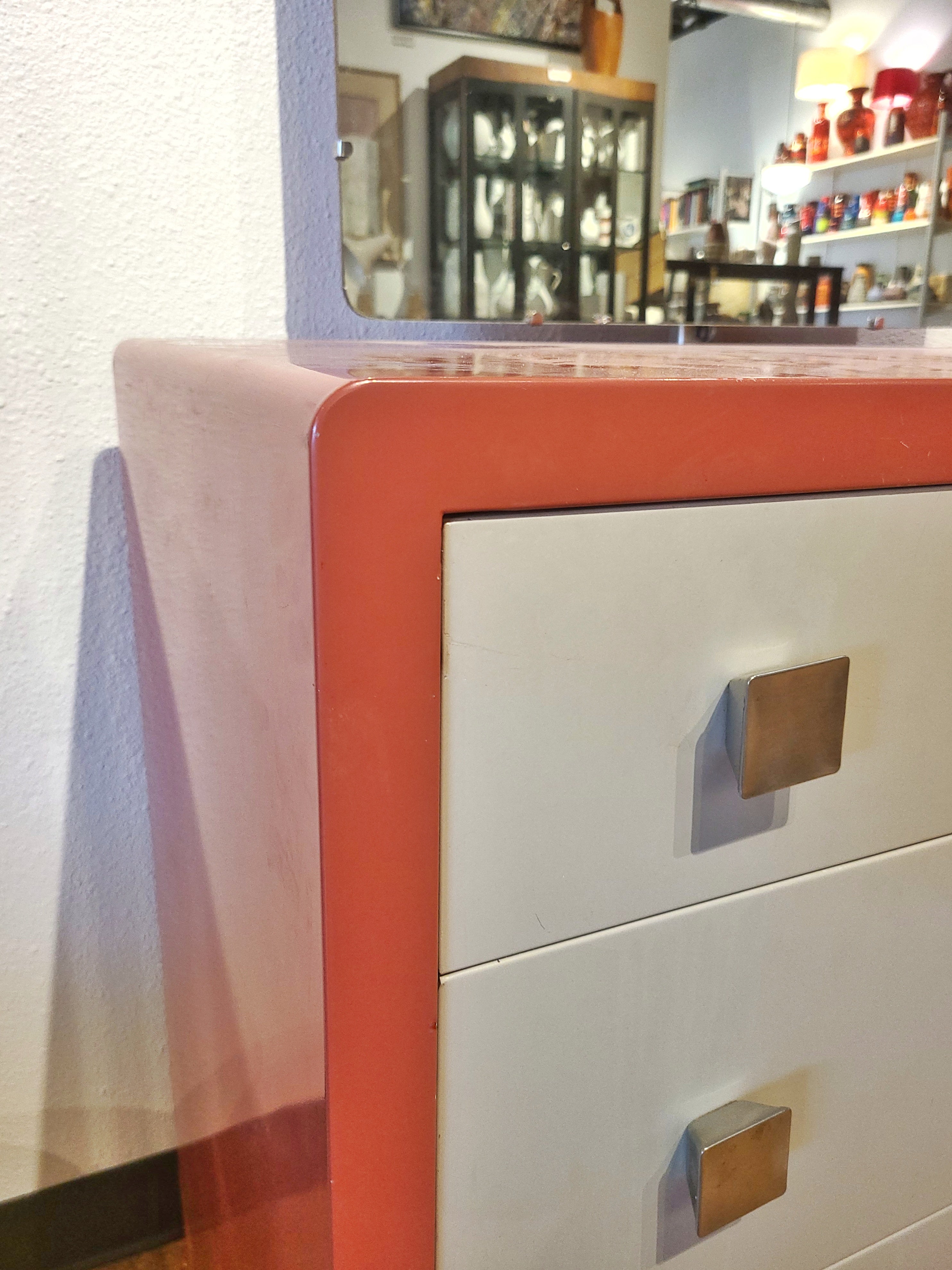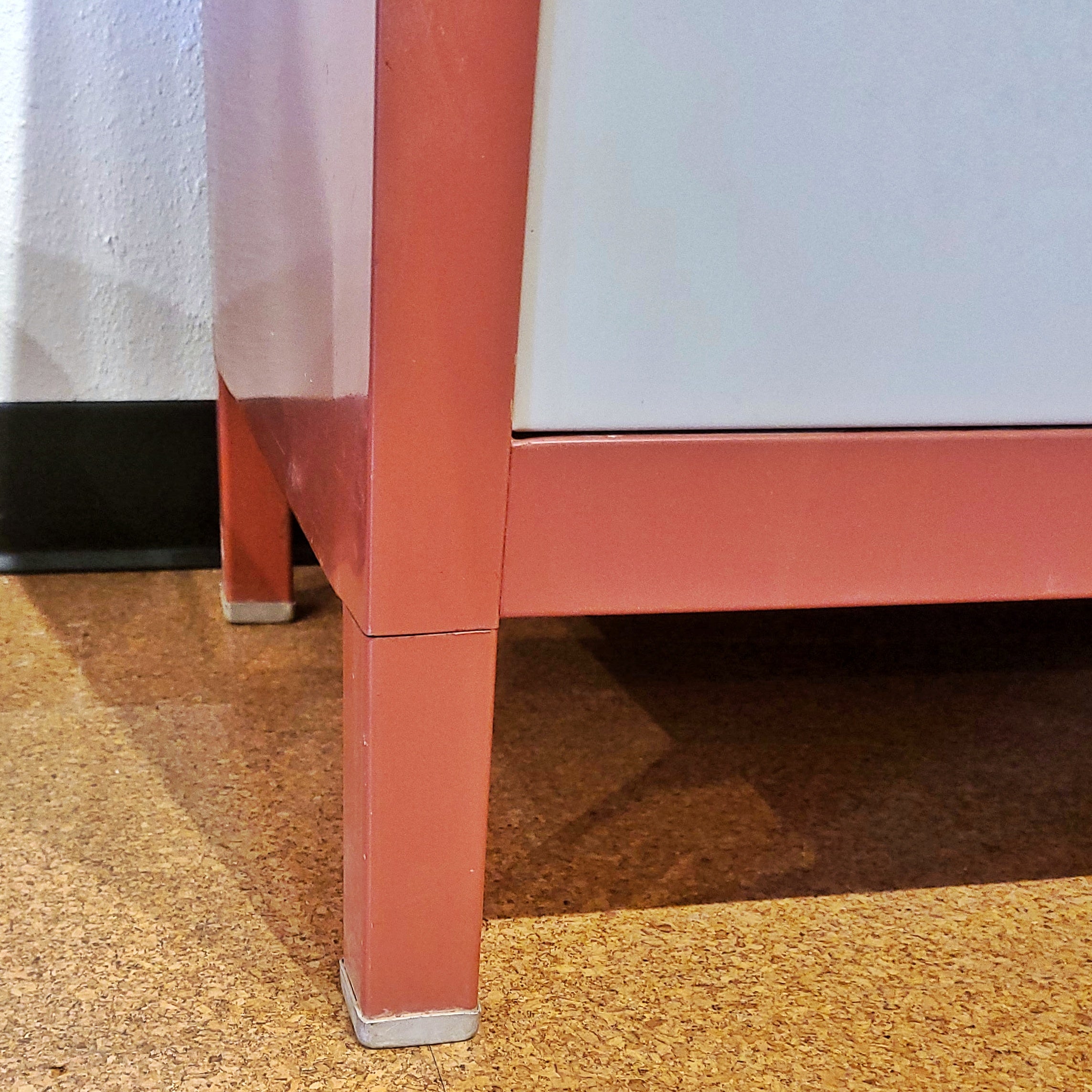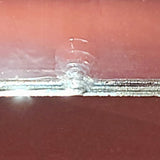











NORMAN BEL GEDDES DRESSER FOR SIMMONS
CONTACT US HERE ABOUT THIS ITEM.
All original coral and cream metal dresser designed by Norman Bel Geddes for Simmons. usually when i find these they have been completely stripped down to the metal and clear coated. It's rare to find one with the original finish in such good condition. Minor dings here and there and two minor nibbles on the bottom edge of the adjustable mirror, but considering its age, this one is in fantastic vintage condition.
NORMAN BEL GEDDES (1893–1958) was an American theatrical and industrial designer. Bel Geddes was born Norman Melancton Geddes in Adrian, Michigan, and raised in New Philadelphia, Ohio, the son of Flora Luelle (née Yingling) and Clifton Terry Geddes, a stockbroker. When he married Helen Belle Schneider in 1916, they combined their names to Bel Geddes. Their daughters were actress Barbara Bel Geddes and writer Joan Ulanov.
Bel Geddes began his career with set designs for Aline Barnsdall's Los Angeles Little Theater in the 1916–17 season, then in 1918 as the scene designer for the Metropolitan Opera in New York. He designed and directed various theatrical works, from 'Arabesque' and 'The Five O'Clock Girl' on Broadway to an ice show, 'It Happened on Ice', produced by Sonja Henie. He also created set designs for the film 'Feet of Clay'. (1924), directed by Cecil B. DeMille, designed costumes for Max Reinhardt, and created the sets for the Broadway production of Sidney Kingsley's 'Dead End' (1935).
Bel Geddes opened an industrial-design studio in 1927, and designed a wide range of commercial products, from cocktail shakers to commemorative medallions to radio cabinets. His designs extended to unrealized futuristic concepts: a teardrop-shaped automobile, and an Art Deco House of Tomorrow. In 1928 Bel Geddes was commissioned by the Simmons Company of Chicago to create a line of modern bedroom furniture. Unlike the modernized classicism of American furniture inspired by French designers, Geddes’s steel furniture, with its right-angled lines and smooth surfaces, looked to the designers of the German Bauhaus or the Dutch DeStijl movement. For the company, Geddes not only designed individual pieces but full ensembles. Previously, Simmons only made beds and nightstands, to which Geddes added dressing tables, a highboy, and various chairs. In 1929, he designed 'Airliner Number 4,' a 9-deck amphibian airliner that incorporated areas for deck-games, an orchestra, a gymnasium, a solarium, and two airplane hangers.
His book 'Horizons' (1932) had a significant impact: "By popularizing streamlining when only a few engineers were considering its functional use, he made possible the design style of the thirties." He wrote forward-looking articles for popular American periodicals, and In the classic science fiction film of H.G, Wells' 'Things to Come' (1936), he assisted production designer William Cameron Menzies on the look of the world of tomorrow.
Bel Geddes designed the General Motors Pavilion, known as Futurama, for the 1939 New York World's Fair. For that famous and enormously influential installation, Bel Geddes exploited his earlier work in the same vein: he had designed a "Metropolis City of 1960" in 1936. Bel Geddes's book 'Magic Motorways' (1940) promoted advances in highway design and transportation, foreshadowing the Interstate Highway System, along with aspects of driver assist and autonomous driving.
The case for the 'Mark I computer' was designed by Norman Bel Geddes. IBM's Thomas Watson presented it to Harvard. At the time, some saw it as a waste of resources, since computing power was in high demand during this part of World War II and those funds could have been used to build additional equipment.
Bel Geddes died in New York on May 8, 1958. His autobiography, 'Miracle in the Evening,' was published posthumously in 1960. He is a member of the American Theater Hall of Fame, a distinction he shares with his daughter, actress Barbara Bel Geddes. The United States Postal Service issued a postage stamp honoring Bel Geddes as a "Pioneer Of American Industrial Design". The archive of Norman Bel Geddes is held by the Harry Ransom Center at the University of Texas at Austin. This large collection includes models, drafts, watercolor designs, research notes, project proposals, and correspondence. The Ransom Center also holds the papers of Bel Geddes' wife, the noted costume designer and producer Edith Lutyens Bel Geddes.
| Designer | Norman bel geddes |
|---|---|
| Manufacturer | Simmons furniture company |
| Design Period | 1920 to 1949 |
| Production Period | 1930 to 1939 |
| Country of Manufacture | United States |
| Identifying Marks | This piece has an attribution mark |
| Style | Vintage, Industrial, Art Deco, Minimalist, Modernist, Bauhaus |
| Detailed Condition | Good — This vintage item remains fully functional, but it shows sign of age through scuffs, dings, faded finishes, minimal upholstery defects, or visible repairs. |
| Restoration and Damage Details | Light wear consistent with age and use, Minor dings here and there and two minor nibbles on the bottom edge of the adjustable mirror |
| Product Code | |
| Materials | Steel, Mirrored Glass, Nickel |
| Color | Coral, cream, silver |
| Width | 38.5 inch |
| Depth | 20.0 inch |
| Height | 64.3 inch |
| Weight Range | Standard — Between 40kg and 80kg |












